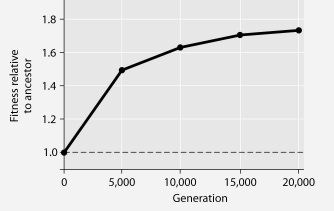Multiple Choice
The following questions refer to Figure 27.1.
In this eight-year experiment, 12 populations of E. coli, each begun from a single cell, were grown in low-glucose conditions for 20,000 generations. Each culture was introduced to fresh growth medium every 24 hours. Occasionally, samples were removed from the populations, and their fitness in low-glucose conditions was tested against that of members sampled from the ancestral (common ancestor) E. coli population.

Figure 27.1
-E. coli cells typically make most of their ATP by metabolizing glucose. Under the conditions of this experiment, what should be true of E. coli's generation time (especially early in the course of the experiment, but less so later on) ?
A) Generation time should be the same as in the typical environment.
B) Generation time should be faster than in the typical environment.
C) Generation time should be slower than in the typical environment.
D) It is theoretically impossible to make any predictions about generation time under these conditions.
Correct Answer:

Verified
Correct Answer:
Verified
Q68: The following table depicts characteristics of five
Q69: Which of the following involves metabolic cooperation
Q70: Genetic variation in bacterial populations cannot result
Q71: The termite gut protist, Mixotricha paradoxa, has
Q72: If a bacterium regenerates from an endospore
Q74: Broad-spectrum antibiotics inhibit the growth of most
Q75: A fish that has been salt-cured subsequently
Q76: Match the numbered terms to the description
Q77: Which two structures play direct roles in
Q78: Figure 27.2 depicts changes to the amount